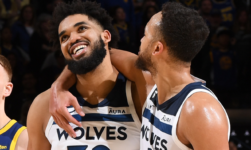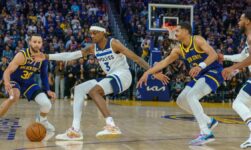LeBron James has signed eight contracts in his NBA career, and while some have been more meaningful than others, each has been eventful in its own way. Two of them were so seismic that they can be easily described with two words — The Decision and The Letter — and several others remain memorable despite needing slightly longer descriptions. The press release that brought him to the Lakers in 2018 was a masterclass in anti-climax. The one-year deal he signed in Cleveland in 2015 (a follow-up to the identical arrangement that came with The Letter) furthered a trend of stars seeking short-term deals. He started that trend himself with a three-year extension following his rookie deal in 2006.
Contractually speaking, James has only recently become boring. After the Lakers won the 2020 championship, he signed a relatively quiet extension that tied him to the Lakers through the end of the 2022-23 season. Little was said about it at the time because, well, things were going well. A defending Finals MVP re-upping with his handpicked championship team in a glamour market rarely registers as news. Of course, this is LeBron James we’re talking about. He never manages to stay boring for long.
James becomes eligible for contract No. 9 this week, and unlike that last one, there has been quite a bit of noise surrounding this possible extension in Los Angeles. So before LeBron can officially put pen to paper, here’s everything you need to know about the extension King James might — or might not — sign in the coming days.
Please check the opt-in box to acknowledge that you would like to subscribe.
Thanks for signing up!
Keep an eye on your inbox.
Sorry!
There was an error processing your subscription.
1. When does LeBron become extension-eligible?
James can sign a new deal with the Lakers on Thursday, Aug. 4. Typically, veteran extensions of this ilk can’t be signed until two years after their last deal was ratified. However, James signed his last contract during the 2020 offseason, which was shifted back as a result of the COVID-19 pandemic. The league has therefore used a mapping table to find equivalent dates on a typical calendar. The 2020 date on which James signed his current deal — Dec. 2 — corresponds with Aug. 4.
2. How much can LeBron make?
The short answer, for those of you who aren’t interested in cap minutia, is a projected $97.1 million over two years. In conjunction with the $44.5 million James is owed next season, he would stand to earn roughly $141.6 million over the next three seasons assuming he is only willing to re-sign for his max.
The long answer is that this contract is a bit of a CBA minefield for a few reasons. In most cases, a player’s maximum salary is tied to his experience. A player with 10 or more years of NBA experience, like James, can make 35 percent of the cap in the first year of a deal. However, James has been in that bracket for so long and has accumulated so many annual raises in an era of relative cap stagnancy (thanks, COVID), that 35 percent of the cap would almost certainly represent a pay cut for him. The CBA fortunately has a workaround for such stars. Any player, regardless of age, is eligible to make five percent more than he did in the previous season. That $97.1 million figure is based on James getting a five percent raise in the first season of a new deal and an eight percent Bird Rights raise afterward.
However, we should note that the salary cap rose dramatically this offseason, and more importantly, the league overshot revenue projections. That pushed this season’s cap several million dollars ahead of where teams expected it to fall. Next season’s cap is projected to fall at around $133 million. If it does, James would stand to make more through a five percent raise on his current salary than 35 percent of the cap. However, if revenue continues to outpace projections and the cap jumps even a little bit higher than $133 million, it’s entirely possible that LeBron’s max winds up being 35 percent of that higher cap. In other words, $97.1 million is a placeholder figure. The actual dollar figures are yet to be determined.
That explains the money side of the equation, but what about contract length? Why is James only extending for two years here? Ironically, it’s because of a rule that he helped fight for as a vice president of the NBPA. The NBA has rules against giving long-term contracts to older players as a defense against cap circumvention. The idea is that teams would otherwise sign older players to long-term contracts, those players would retire, and then those teams would continue to pay them, essentially giving them multiple seasons of salary they might not otherwise be able to fit under the cap for fewer seasons of work. The cutoff for this line was once 36. James and Chris Paul fought to have it moved back to 38.
But James will turn 38 in December. That doesn’t mean that the Lakers can’t extend him. It just means that any extension he signs will be subject to the NBA’s over-38 restriction. The rule itself is immensely complicated, but the short version is that it treats salary devoted to players beyond their 38th birthday in future seasons as deferred compensation, which still counts against the cap in present seasons. Adding deferred compensation to James’ cap number in the present would be impossible because he’s already making the max. However, this rule only applies to deals lasting four years or more. If James signs a two-year extension, he’ll only be under contract for three total seasons. The over-38 rule won’t apply.
3. LeBron can sign this extension … but will he?
The prevailing wisdom is, and has always been, that James would like to remain in Los Angeles. Marc Stein recently reported as much, and others have frequently over the past several years. For the time being, James does not appear ready to leave Los Angeles.
But that doesn’t guarantee an extension this offseason. James frequently used his contract status to pressure the Cavaliers into making certain moves during his second stint with the Cavaliers. It’s a tactic he had to adopt after the Miami Heat waived close friend and valued teammate Mike Miller to save some luxury-tax dollars in 2014. He expects his teams to spend, both in terms of salary and, when necessary, draft capital.
Budgetary constraints didn’t help matters last season, when the Lakers low-balled Alex Caruso and tried to spin it publicly by leaking tax concerns. Caruso wouldn’t have prevented last season’s debacle, but it’s hard to believe their No. 1 defense falls all the way to No. 21 with him. The more present concern revolves around picks. The Lakers have two tradable first-round picks: 2027 and 2029. To this point, they are not known to have been offered for anybody. Reports indicate that putting both on the table would at least net Buddy Hield and Myles Turner. It could potentially land Kyrie Irving.
That is who James would reportedly like to play with, and perhaps more importantly, such a trade would get Russell Westbrook off of the team. If James believes that a Westbrook trade is his only way back into the championship picture, he can use free agency as leverage to try to force the Lakers into giving up the picks necessary to make one. Once he re-signs, that option is off the table, and the Lakers suddenly become free to waste another season without consequence. Speaking of the Lakers, how do they feel about all of this?
4. We’re sure the Lakers are offering this extension, right?
All indications suggest that the Lakers do indeed plan to offer James a max extension. Frankly, doing so makes sense regardless of their long-term ambitions. The Lakers control only one of their next three first-round picks. Their draft capital will be limited whether James stays or goes. They cannot rebuild in the traditional sense, but keeping James at least guarantees them a box office draw and some measure of relevance.
But the Lakers probably wouldn’t be too broken up about it if James decided to reject an extension offer. In the short term, James waiting would help the Lakers retain as much cap space as possible for the summer of 2023, when only Anthony Davis, Talen Horton-Tucker, Damian Jones and Max Christie are under contract. If James re-signs for his max, the Lakers will have over $100 million committed to five players. That’s still plenty of space against a $133 million cap, but with incomplete roster charges factored in, it’s not close to the max. But if James doesn’t extend? The Lakers suddenly have significantly more than a single max slot, and James could tailor his next contract to the team’s needs. In all likelihood, that would mean leaving a bit of money on the table so the Lakers could chase Irving in free agency. Once he signs, his salary is locked in.
And it’s worth asking … is James going to be worth the max in his ages 39 and 40 seasons? It’s a somewhat preposterous thought considering James has been worth the max for the better part of two decades, but sooner or later, James is going to decline. But if the Lakers aren’t going to invest the money and picks necessary to contend now, when James is still a superstar, getting out of the LeBron business before his eventual downfall might not be the worst idea. Letting James go in 2023 might mean trading Davis before his 2024 free agency and accepting a few lean years, but that bill is coming due eventually. The immediate aftermath of the James era is going to be ugly for the Lakers, so if they aren’t going to take the necessary steps to contend with him, they might not mind getting a head start on the teardown that will inevitably come.
For now, this is all academic. The Lakers are expected to offer James the max. But if he doesn’t take it, it’s going to have ripple effects throughout the league.
5. Who else is monitoring the situation?
We’ve already mentioned two teams that are watching all of this closely: the Indiana Pacers and Brooklyn Nets. If James doesn’t extend as a means of pressuring the Lakers into a making a win-now trade, both of them gain a little bit of negotiating leverage. Neither is in a particularly enviable position themselves, but hey, when you want to make a trade, it helps to have LeBron James telling the GM you’re negotiating it with that he wants the deal to get done.
But we haven’t covered the most important lurker of them all. As of right now, the Cleveland Cavaliers are positioned to have something like $25 million in 2023 cap space. That number can easily jump up above $30 million if they waive Cedi Osman, and if they need to open up a starting spot at small forward, Lauri Markkanen and his $17.3 million salary for the 2023-24 should be relatively tradable. If James wants a contender and the Lakers won’t give him one, the Cavs certainly could. While Cleveland has taken some pride in building their first winner without James in decades, the Cavaliers could ask for no better mentor for their young stars than James. You could argue that slotting James onto the current Cavaliers would make Cleveland the Eastern Conference favorite right now.
A lot could change in a year. James could finally lose his endless battle with Father Time. Cleveland could wipe away its cap space by extending Caris LeVert or re-signing Collin Sexton to a multi-year deal. Cleveland isn’t all-in on a third James stint quite yet, but if he elects not to re-sign with Los Angeles, you can bet they’ll start preparing for the possibility. But with Stein and others reporting James would prefer to stay in Los Angeles, for now, we can consider this possibility remote.
6. So what do the next few years look like if James extends?
The most obvious effect of a James extension is that it would essentially trigger a countdown to the summer of 2024. At that point, both James and Davis would presumably have player options. James has made it known he plans to play for whatever team drafts his son Bronny. If James leaves the Lakers, Davis would likely consider his own exit strategy. This era of Lakers basketball probably ends in July of 2024.
And if that happens, the New Orleans Pelicans start popping champagne bottles. They currently own a first-round pick from the Lakers that will convey in either 2024 or 2025. The Pelicans choose when, and an unprotected Lakers pick after James and Davis leaves would almost certainly land near the top of the lottery. The Lakers would have no choice but to take their medicine and accept the bounty they’ve handed to the Pelicans.
But depending on how the rest of this offseason goes? Things don’t have to be too bad after that. If they don’t surrender additional draft capital in a Russell Westbrook trade, they’d be in the clear after handing New Orleans that last pick. They could rebuild in earnest at that point.
If they have given up picks in a Westbrook deal? The entire equation changes, because the Lakers are suddenly a significantly better team in the present. Perhaps James stays beyond 2024. Davis would be far likelier to extend, and any players acquired in a Westbrook trade could be around to help. Until we know what happens with Westbrook, LeBron’s future almost doesn’t matter. All we can say with relative certainty is that, like the eight contracts James has signed to this point, his ninth deal is going to be one of the more eventful pacts in basketball.






